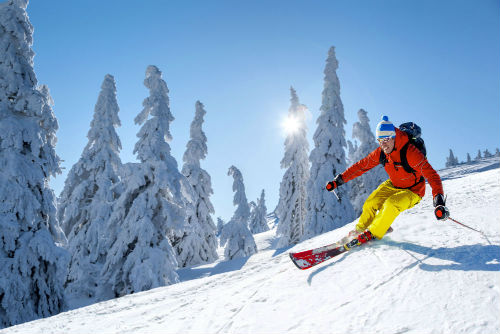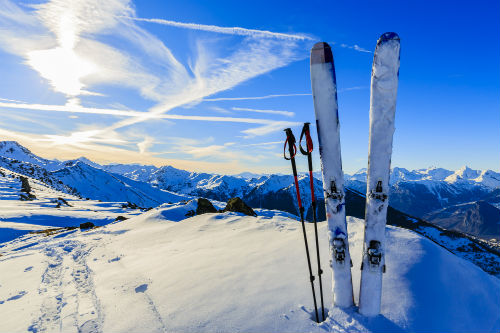With more than 5,000 acres of developed terrain, Vail is one of the world’s largest ski resorts. Known primarily for its stunning slopes, the area is also famous for the vibrant villages that fringe the base of the mountain. To make sure you get the most from your visit, it’s important to thoroughly prepare. Here’s your definitive guide for what to pack for a ski trip in Vail, Colorado.
With more than 5,000 acres of developed terrain, Vail is one of the world’s largest ski resorts. Known primarily for its stunning slopes, the area is also famous for the vibrant villages that fringe the base of the mountain. To make sure you get the most from your visit, it’s important to thoroughly prepare. Here’s your definitive guide for what to pack for a ski trip in Vail, Colorado.
Pack Layers of Clothing
Pack Layers of Clothing
 Any local will tell you Vail’s weather can change on a dime. Prepare for this by packing layers of clothing you can strip away as needed. It’s important to have a base layer of clothing that will keep you warm and dry. Start by packing long-sleeved t-shirts and leggings made from polyester or another good moisture-wicking fabric. Avoid cotton clothing which tends to hold moisture against your body and make you feel colder.
Any local will tell you Vail’s weather can change on a dime. Prepare for this by packing layers of clothing you can strip away as needed. It’s important to have a base layer of clothing that will keep you warm and dry. Start by packing long-sleeved t-shirts and leggings made from polyester or another good moisture-wicking fabric. Avoid cotton clothing which tends to hold moisture against your body and make you feel colder.
 Any local will tell you Vail’s weather can change on a dime. Prepare for this by packing layers of clothing you can strip away as needed. It’s important to have a base layer of clothing that will keep you warm and dry. Start by packing long-sleeved t-shirts and leggings made from polyester or another good moisture-wicking fabric. Avoid cotton clothing which tends to hold moisture against your body and make you feel colder.
Any local will tell you Vail’s weather can change on a dime. Prepare for this by packing layers of clothing you can strip away as needed. It’s important to have a base layer of clothing that will keep you warm and dry. Start by packing long-sleeved t-shirts and leggings made from polyester or another good moisture-wicking fabric. Avoid cotton clothing which tends to hold moisture against your body and make you feel colder.

Pack a second layer of sweatshirts and fleece pants to wear over the top of your base layer. This will help shield you from whipping winds that can chill you to the bone at high elevations. You can use lightweight Merino wool clothing as a mid-layer. Just remember that wool fabrics are heavier and take a considerable time to dry when saturated with melted snow and sweat.
Pack a second layer of sweatshirts and fleece pants to wear over the top of your base layer. This will help shield you from whipping winds that can chill you to the bone at high elevations. You can use lightweight Merino wool clothing as a mid-layer. Just remember that wool fabrics are heavier and take a considerable time to dry when saturated with melted snow and sweat.
For your outer layer, select a nice warm parka and ski or snowboard pants. Double-check the label to make sure all your outerwear is waterproof. You should also try on any new clothing you buy to make sure it fits comfortably without feeling too bulky.
For your outer layer, select a nice warm parka and ski or snowboard pants. Double-check the label to make sure all your outerwear is waterproof. You should also try on any new clothing you buy to make sure it fits comfortably without feeling too bulky.
Socks, Gloves and Hats
Socks, Gloves and Hats
It may sound silly, but socks can make or break your ski trip in Vail. Ideally, your socks should be warm but thin. Seasoned skiers typically prefer socks made from thin wool, silk or a wool-silk blend. Whatever you choose, avoid thicker socks which gather up sweat and hold moisture against your feet. Thinner socks tend to move sweat from your feet to the liner, which is made to wick moisture from your body. Bulkier socks also tend to bunch up and reduce circulation, causing your feet to feel even colder.
It may sound silly, but socks can make or break your ski trip in Vail. Ideally, your socks should be warm but thin. Seasoned skiers typically prefer socks made from thin wool, silk or a wool-silk blend. Whatever you choose, avoid thicker socks which gather up sweat and hold moisture against your feet. Thinner socks tend to move sweat from your feet to the liner, which is made to wick moisture from your body. Bulkier socks also tend to bunch up and reduce circulation, causing your feet to feel even colder.
Once you’ve packed plenty of socks, turn your attention toward hats, scarves and neck gaiters. These should be made of wool or fleece and should fit comfortably and securely. Bring along waterproof mittens or gloves with a fleece liner and Gore-Tex shell. While mittens are the best way to keep your hands and fingers warm; gloves will give you better dexterity to zip up jackets, grip ski poles and pick up small items. Whatever you choose, consider adding a warm pair of glove liners to keep your fingers extra cozy on the slopes.
Once you’ve packed plenty of socks, turn your attention toward hats, scarves and neck gaiters. These should be made of wool or fleece and should fit comfortably and securely. Bring along waterproof mittens or gloves with a fleece liner and Gore-Tex shell. While mittens are the best way to keep your hands and fingers warm; gloves will give you better dexterity to zip up jackets, grip ski poles and pick up small items. Whatever you choose, consider adding a warm pair of glove liners to keep your fingers extra cozy on the slopes.
Other Essential Items
Other Essential Items
Because snow can reflect and intensify sunlight, bring along plenty of waterproof sunscreen. You should also pack sunglasses, lip balm and ski goggles with interchangeable, anti-fog lenses that help you cope with varying lighting conditions on the slopes.
Because snow can reflect and intensify sunlight, bring along plenty of waterproof sunscreen. You should also pack sunglasses, lip balm and ski goggles with interchangeable, anti-fog lenses that help you cope with varying lighting conditions on the slopes.
When deciding what to pack on a ski trip, remember that you will be a lot more comfortable if you bring plenty of basic clothing items, including underwear, flannel pajamas, slippers and regular everyday socks. You should also toss a few pairs of jeans, shirts, sweaters and shoes in your suitcase, so you can shop and dine in comfort after a full day on the slopes.
When deciding what to pack on a ski trip, remember that you will be a lot more comfortable if you bring plenty of basic clothing items, including underwear, flannel pajamas, slippers and regular everyday socks. You should also toss a few pairs of jeans, shirts, sweaters and shoes in your suitcase, so you can shop and dine in comfort after a full day on the slopes.
Packing Ski Equipment
Packing Ski Equipment
If you own ski equipment and plan to bring it with you, choose bags specifically designed for boots, poles, helmets, skis and/or snowboards.  If you are arriving in Vail by car, you can stow these bags inside or atop your vehicle on racks. If you’re flying and really want to use your own gear, purchase a ski/snowboard case to protect each item from damage.
If you are arriving in Vail by car, you can stow these bags inside or atop your vehicle on racks. If you’re flying and really want to use your own gear, purchase a ski/snowboard case to protect each item from damage.
If you own ski equipment and plan to bring it with you, choose bags specifically designed for boots, poles, helmets, skis and/or snowboards.  If you are arriving in Vail by car, you can stow these bags inside or atop your vehicle on racks. If you’re flying and really want to use your own gear, purchase a ski/snowboard case to protect each item from damage.
If you are arriving in Vail by car, you can stow these bags inside or atop your vehicle on racks. If you’re flying and really want to use your own gear, purchase a ski/snowboard case to protect each item from damage.

You can try to bring your boots as a carry-on item, but it’s generally best to contact the airline for rules and guidelines related to flying with sporting equipment. If traveling with so much gear sounds like a hassle, you can always rent your gear from American Ski Exchange, which offers the best-priced ski and snowboard packages in all of Vail Village.
You can try to bring your boots as a carry-on item, but it’s generally best to contact the airline for rules and guidelines related to flying with sporting equipment. If traveling with so much gear sounds like a hassle, you can always rent your gear from American Ski Exchange, which offers the best-priced ski and snowboard packages in all of Vail Village.
American Ski Exchange
for all your ski equipment needs.
